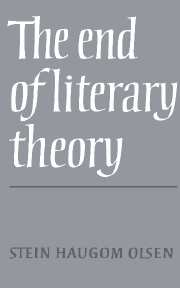Book contents
- Frontmatter
- Contents
- Preface
- Literary aesthetics and literary practice
- Interpretation and intention
- Authorial intention
- Text and meaning
- The ‘meaning’ of a literary work
- Defining a literary work
- What is poetics?
- On unilluminating criticism
- Criticism and appreciation
- Value-judgements in criticism
- Literature, fiction, and reality. A problematic relationship
- Thematic concepts: where philosophy meets literature
- Literary theory and literary aesthetics
- Notes
- Bibliography
- Index
Interpretation and intention
Published online by Cambridge University Press: 05 November 2011
- Frontmatter
- Contents
- Preface
- Literary aesthetics and literary practice
- Interpretation and intention
- Authorial intention
- Text and meaning
- The ‘meaning’ of a literary work
- Defining a literary work
- What is poetics?
- On unilluminating criticism
- Criticism and appreciation
- Value-judgements in criticism
- Literature, fiction, and reality. A problematic relationship
- Thematic concepts: where philosophy meets literature
- Literary theory and literary aesthetics
- Notes
- Bibliography
- Index
Summary
ONE
Literary interpretation is central to the social institution which is constituted by the writing and reading of literary works. It is not identical with criticism, for criticism is an amorphous concept covering many types of different interest while interpretation is specifically concerned with understanding. In so far as any further comments on a literary work must be based on its proper understanding, interpretation must be said to be prior to criticism; considered as one of its parts, it is the most basic part.
Literary interpretation can be divided into two logically separate stages: identification and explanation. Identification has logical priority over explanation. It is necessary to subsume an object under a description in order to place it on one's conceptual map. The most important motivation for placing an object in this way is that it provides one with a source of information about how the object can be expected to behave. Thus identification is a necessary step in the attempt to deal with an object in a rational way. If one classifies an object as a stone, one assumes that it will turn out to possess properties and conform to the behaviour which one has come to accept as normal for stones. One would therefore refrain from kicking it or lifting it (if it was big), since this might result in a broken toe or a damaged spine.
- Type
- Chapter
- Information
- The End of Literary Theory , pp. 20 - 28Publisher: Cambridge University PressPrint publication year: 1987



